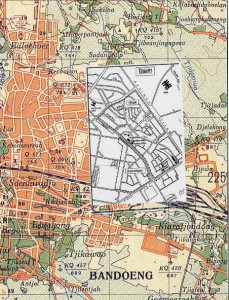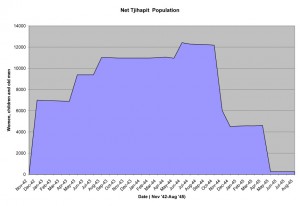Tjihapit Camp
Tjihapit
 Tjihapit Camp was the biggest of the Bandoeng Camps for Women and Children in South East Asia. The accompanying map highlights the location in the north east corner of pre-war Bandung. The book Tjideng Reunion provides the most authoritative account the history of this camp and how the changing fortunes of the Pacific War impacted our daily lives. Capturing the oil fields of Indonesia was the primary objective of the Japanese onslaught unleashed on 7 December 1941, but that entailed controlling the administrative centres of the Netherlands East Indies, especially Batavia and Bandoeng with their large European and Europeanized populations.
Tjihapit Camp was the biggest of the Bandoeng Camps for Women and Children in South East Asia. The accompanying map highlights the location in the north east corner of pre-war Bandung. The book Tjideng Reunion provides the most authoritative account the history of this camp and how the changing fortunes of the Pacific War impacted our daily lives. Capturing the oil fields of Indonesia was the primary objective of the Japanese onslaught unleashed on 7 December 1941, but that entailed controlling the administrative centres of the Netherlands East Indies, especially Batavia and Bandoeng with their large European and Europeanized populations.
Compiling this story about camp life was a huge challenge because of the almost complete absence of any authoritative documentation. A reunion of camp survivors precipitated in 1990 the publication of an informal and rather haphazard collection of memories. The only authoritative source of information that the author found was a fragment of the list of inmates in January 1945 (see below). The author was fortunate in being able to interview a number of camp survivors, including Emelia de Visser, who had worked in the camp administrative office and also had published her recollections. I gained access to the sole diary that survived this camp, that of a teen-aged girl, whose parents happened to be prewar acquaintances of my family and last but not least fragments of written material from other fellow inmates and friends. Some very helpful observations by a journalist who remained hidden in Bandoeng throughout the war, but based on hearsay, also assisted.
Tjihapit camp began as a suburb in northeast Bandoeng (today’s Bandung) from where all non-Europeans were evicted at short notice in order to make place for a racially pure population deemed to be anti-Japanese. From the Bandoeng Address book it is possible to obtain an impression of the number of families affected, their status in society and their likely ethnic composition. Gradually family members with Axis connections, Jews , and Eurasians got interned here as well. With time the density of home occupancy grew to 30 persons per single family dwellings some of which were extremely modest.
The number of internees is thought to have peaked at about 14,000. During the early stages of occupation included older European men. Gradually a gender sieve was applied the to the camp population to winnow out all males over ten years old- very old men and young boys, both of whom faced an uncertain but harsh future. After October 1944 a camp liquidation process was started, with women and children transported to various other camps in groups of about 600, a trainload. One can only speculate that these moves were driven as a defensive measure against an Allied invasion. An Allied invasion was never on the cards.
Camp liquidation was accompanied by strict control over all personal effects. Virtually all documentation such as passports and birth certificates were confiscated, and the amount of personal possessions that could be kept was limited to 20 Kg, including such household items as emergency food and medicine, chamber pots, dishes and cups. The destination and purpose of this movement of people was never made clear and it was widely rumored that we would all be sent to the jungles of Borneo to fend for ourselves.
It is because of this process that hardly any documentation survived the war. Although a very detailed list of names on index cards had been maintained by the camp administration, these cards were sent with the groups of inmates to other destinations as part of the camp liquidation process. By a matter of good fortune the list of inmates remaining in the camp after January 1945 has been preserved but by then the liquidation process was 75% complete.

The graph depicts “net population.” Until October 1944 fresh arrivals of Europeans from the rural areas and smaller towns was offset by the eviction of old men and teen aged boys. The peak population between May 1944 and October 1944 occurred when the populations of two other Bandoeng camps, mainly Karees and Bloemenkamp, were forced into Tjihapit.
At the end of the war most of the interned civilian men were located in Tjimahi, 16 km west of Bandoeng and the women were imprisoned either in the Batavia ( Jakarta ) area or in camps in mid-Java.
Leave a Reply